Hollywood Cemetery (Richmond, Virginia)
Hollywood Cemetery is a large, sprawling cemetery located next to Richmond, Virginia's Oregon Hill neighborhood at 412 South Cherry Street. Characterized by rolling hills and winding paths overlooking the James River, it is the resting place of two United States Presidents, James Monroe and John Tyler, as well as the only Confederate States President, Jefferson Davis. It is also the resting place of 28 Confederate generals, more than any other cemetery in the country; these include George Pickett and J.E.B. Stuart.[3]
| Hollywood Cemetery | |
|---|---|
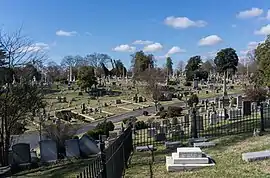 | |
| Details | |
| Established | 1849 |
| Country | United States |
| Website | www |
| Find a Grave | Hollywood Cemetery |
Hollywood Cemetery | |
| Location | 412 S. Cherry St., Richmond, Virginia |
| Coordinates | 37°32′09″N 77°27′25″W |
| Area | 130 acres (526,000 m2) |
| Built | 1860 |
| Architect | Pratt, William H. |
| NRHP reference No. | 69000350[1] |
| VLR No. | 127-0221 |
| Significant dates | |
| Added to NRHP | November 12, 1969 |
| Designated VLR | September 9, 1969[2] |
History
The land that Hollywood Cemetery currently stands on was once part of William Byrd III's estate. Later, it was owned by the Harvie family and was known as "Harvie's Woods."[3] William H. Haxall was one of the original founders of Hollywood Cemetery. In the spring of 1847, two citizens of Richmond, Joshua J. Fry and William H. Haxall, while on a visit to Boston, visited Mount Auburn Cemetery, a beautiful cemetery near that city. They were impressed by the solemn grandeur of the place and resolved that they would, on their return to Richmond, propose the establishment of a rural cemetery near the city. It was through their original efforts and the subsequent cooperation of local citizens that Hollywood Cemetery was created. On June 3, 1847, Haxall, Fry, William Mitchell Jr., and Isaac Davenport Sr. purchased from Lewis E. Harvie, who sold under a deed of trust from Jacqueline B. Harvie for the sum of $4,075, a certain portion of the lots or parcels of land in the town of Sydney, in the County of Henrico, together with "the privileges and appurtenances to the belonging, which said portion is adjoining to Clarkes Spring and contains by survey forty-two acres, three roods, but of which one rood, known as Harvie's rood, or graveyard, with free ingress and egress to the said graveyard is reserved." This purchase was made with the design of establishing a rural cemetery.[4] Hollywood Cemetery was designed as a garden cemetery, or park cemetery, which was the trend at the time borrowed from the French in an effort to provide more green space in urban areas.
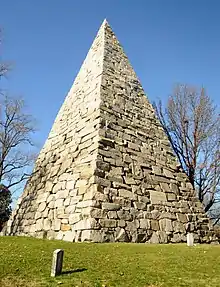
In the late 1840s, William Haxall, William Mitchell Jr. and Joshua Fry hired John Notman (architect of Laurel Hill Cemetery in Philadelphia) to design the cemetery in the rural garden style. Its name, "Hollywood," came from the holly trees dotting the hills of the property.[3] Oliver P. Baldwin[5] delivered the dedication address in 1849.[6]
James Monroe was reinterred from New York City to the "President's Circle" section of Hollywood cemetery on July 4, 1858, due to the efforts of Governor Henry A. Wise.[3]
In 1869, a 90-foot (27 m) high granite pyramid designed by Charles H. Dimmock was built as a memorial to the more than 18,000 enlisted men of the Confederate Army buried in the cemetery. It was a project supported by the Hollywood Ladies Memorial Association, a group of Southern women dedicated to honoring and caring for the burial sites of fallen Confederate soldiers.
The placing of the capstone at the top of the pyramid has been a source of legend for Richmonders. The legend states that, as it was nearing completion, no one could determine how to place the capstone atop the lofty 90-foot pyramid. Thomas Stanley, a criminal in the work gang building the pyramid, proposed and executed the solution, which involved a dangerous climb to the top. In retellings, locals say Stanley was freed due to his heroic contribution. The only evidence of this is a note reading "transferred" added to the release box of Stanley's prison schedule. This note could be interpreted as an attempt to obscure the extrajudicial granting of his freedom or that he was simply moved to a different prison or project.
The pyramid became a symbol of the Hollywood Memorial Association, appearing on its stationery as well as on the front of a pamphlet of buried soldiers, the Register of the Confederate Dead.[7]
In 1890, a chapel was constructed next to the entrance of the cemetery. This chapel now serves as the cemetery office. In 1915, the original entrance was closed and the present one was opened to better facilitate cars.[3]

The Palmer Chapel Mausoleum was built 1992, adding 730 crypts for caskets and 160 cremation niches.[8]
Hollywood Cemetery is one of Richmond's major tourist attractions. There are many local legends surrounding certain tombs and grave sites in the cemetery, including one about a little girl and the black iron statue of a dog standing watch over her grave.[9] Other notable legends rely on ghosts haunting the many mausoleums. One of the most well-known of these is the legend of the Richmond Vampire.
A place rich in history, legend, and gothic landscape, Hollywood Cemetery is also frequented by many of the local students attending Virginia Commonwealth University.
Confederate Memorial Day
In the 1870s, the South was crumbling, and southerners yearned to preserve their culture and heritage. One preservation effort was Confederate Memorial Day, a series of celebrations that “became imbued with cultural and religious symbolism that underscored the gravity of what it meant to be a southerner.”[10] Though some of these celebrations were ornate with speeches, poems, and prayers, the ones at Hollywood Cemetery were simple, and ultimately set the trend for future celebrations: a modest procession to the cemetery and decoration of the graves. Young men would also recreate Thomas Stanley's heroic act and climb the monument to hang a wreath from the top. Though simple, it is estimated that around 20,000 people attended the first Confederate Memorial Day at Hollywood Cemetery in 1866.
List of notable interments and their families
(Note: This is a partial list.)
Use the following alphabetical links to find names.
A
- Alden Aaroe (1918–1993), broadcast journalist
- Carl William Ackerman (1890–1970), journalist, author and educational administrator, the first dean of the Columbia School of Journalism
- George Wayne Anderson (1863–1922), Virginia state delegate and senator[11]
- Adeline Detroit Wood Atkinson (1841–1916), hotelier and proprietor of Hotel Richmond
- Joseph R. Anderson (1813–1892), civil engineer, industrialist, soldier
- T. Coleman Andrews (1899–1983), Commissioner of Internal Revenue, presidential candidate of the State's Rights Democratic Party in 1956
- James J. Archer (1817–1864), Confederate General, American Civil War
- Grace Evelyn Arents (1848–1926), philanthropist, niece of Lewis Ginter
B
- William Barret (1786–1871), businessman, tobacco manufacturer in his time considered to have been the wealthiest man in Richmond
- Lloyd James Beall (1808–1887), American military officer and paymaster of U.S. Army, Colonel Commandant of the Confederate States Marine Corps for the entire length of the War
- Frederic W. Boatwright (1868–1951), President of the University of Richmond (1895–1946)
- Kate Langley Bosher (1865–1932), author, suffragette
- John Fulmer Bright (1877–1953), politician, physician
- John M. Brockenbrough (1830–1892), Confederate Army colonel and brigade commander at Gettysburg
- Dave Brockie (1963–2014) musician, painter, author, and actor. Brockie portrayed Oderus Urungus, lead singer of the band Gwar
- Benjamin Thomas Brockman (1831–1864), merchant and Confederate officer
- James Andrew Bryant Jun 27th 1862 34th NC. Walter Bailoch Stewert EARL OF MENTEITH Descendant. Royal Stewarts y-Dna project James Brian 1760-1830 York county SC.
C
- James Branch Cabell (1879–1958), fantasy fiction novelist
- James E. Cannon (1873–1942), Virginia state senator (1914–23)
- John Samuels Caskie (1821–1869), U.S. Congressman (1851–59)
- Ralph T. Catterall (1897–1978), judge, Virginia State Corporation Commission (1949–73)
- Robert H. Chilton (1815–1879), US Army Officer, Confederate General, American Civil War
- Philip St. George Cocke (1809–1861), Confederate General, American Civil War
- Raleigh Edward Colston (1825–1896), Confederate Civil War general and VMI professor
- Asbury Christian Compton (1929–2006), Justice, Supreme Court of Virginia (1974–2000)
- John Rogers Cooke (1833–1891), Confederate General, American Civil War
- Edward Cooper (1873–1928), U.S. Congressman (1915–19)
- Jabez Lamar Monroe Curry (1825–1903), U.S. and Confederate Congressman, Civil War veteran, and President of Howard College in Alabama and Richmond College in Virginia. His statue is in Statuary Hall in the U.S. Capitol
D
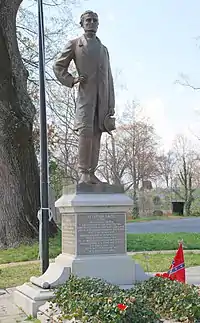
- Virginius Dabney (1901–1995) author, journalist, editor of the Richmond Times-Dispatch from 1936 to 1969, Pulitzer Prize winner
- Peter V. Daniel (1784–1860), U.S. Supreme Court Associate Justice
- Robert Williams Daniel (1884–1940), Virginia State Senator and RMS Titanic survivor. Father of Robert Daniel
- Robert Daniel (1936–2012), U.S. Representative from Virginia. Son of Robert Williams Daniel
- Jefferson Davis (1808–1889), President of the Confederate States of America
- Varina Anne "Winnie" Davis (1864–1898), author, daughter of Jefferson Davis
- Varina Howell Davis, (1826–1906), author best known as First Lady of the CSA, wife of Jefferson Davis
- Hal Douglas (1924–2014), radio and television voice over artist
E
- Edward Edmonds (1835–1863), Confederate Colonel of the 38th Virginia Infantry, killed-in-action during Pickett's Charge
- Tazewell Ellett (1856–1914), U.S. Representative from Virginia
- James Taylor Ellyson (1847–1919), Lieutenant Governor of Virginia (1906–18)
F
- Douglas Southall Freeman (1886–1953), journalist and historian; author of definitive biographies of George Washington and Confederate General Robert E. Lee; namesake of a local high school[12]
G
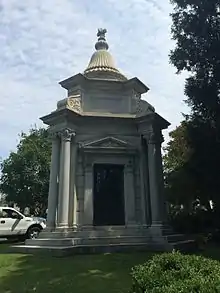

- Richard B. Garnett (1817–1863), U.S. Army officer and Confederate general killed during Battle of Gettysburg
- Julian Vaughan Gary (1892–1973), U.S. Congressman (1945–65)
- Robert Atkinson Gibson (d. 1919), Bishop of the Episcopal Diocese of Virginia (1902–19)
- Lewis Ginter (1824–1897), tobacco executive, philanthropist
- Ellen Glasgow (1873–1945), Pulitzer Prize winning novelist
- Thomas Christian Gordon Jr. (1915–2003), Justice, Supreme Court of Virginia (1965–1972)
- W. Douglas Gordon (1876–1944), newspaper editor
- Peachy R. Grattan (1801–1881), lawyer and law reporter
- Charles Philip Gruchy (died 1921), Private, 3rd Battalion, Canadian Infantry – only British Commonwealth war grave in the cemetery[13]
- Walter Gwynn (1802–1882), Confederate Brigadier General
H
- James Dandridge Halyburton (1803–1879), U.S. and Confederate judge, Eastern District of Virginia (1843–65)
- David Bullock Harris (1814–1864), Confederate Colonel
- John Harvie (1742–1807), lawyer and builder, delegate to the Continental Congress, Signer of The Articles of Confederation
- William Wirt Henry (1831–1900), lawyer, member of the General Assembly of Va., president of the Am. Historical Association (1890–91)
- Henry Heth (1825–1899), U.S. Army officer and Confederate general, participated at the Battle of Gettysburg
- Eppa Hunton (1822–1908), U.S. Representative and Senator, Confederate brigadier general
- Eppa Hunton Jr. (1855–1932), lawyer, member of the House of Delegates, president of the Virginia Bar Association
- Eppa Hunton IV (1904–1976), lawyer, rector of Virginia Commonwealth University
I
- John D. Imboden (1823–1895), lawyer, teacher, Virginia legislator, Confederate cavalry general and partisan fighter
J
- Edward Johnson (1816–1873), U.S. Army officer and Confederate general, American Civil War
- Mary Johnston (1870–1936), novelist and women's rights advocate
- David Rumph Jones (1825–1863), U.S. Army officer and Confederate General, American Civil War
- Samuel Jones (1819–1887), U.S. Army, Confederate General, American Civil War
K
- Wythe Leigh Kinsolving (1878–1964), Episcopal priest, writer, poet, political advocate
L
- John Lamb (1840–1924), U.S. Congressman (1897–1913)
- Fitzhugh Lee (1835–1905), Confederate cavalry general, Governor of Virginia, diplomat, U.S. Army general in Spanish–American War and the nephew of General Robert E. Lee
- Thomas M. Logan (1840–1914), Confederate General
- James Lyons (1801–1882), politician, Confederate Congressman
M
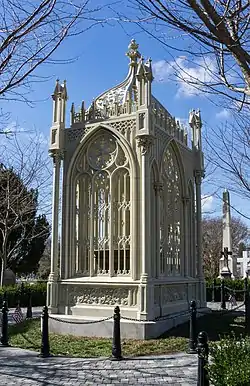
- Hunter McGuire (1835–1900), Confederate Army surgeon who amputated General Thomas J. "Stonewall" Jackson's arm after Jackson was mistakenly shot by Confederate soldiers at Chancellorsville . (Despite McGuire's efforts, Jackson later died of pneumonia.) After the war, McGuire founded the Virginia College of Medicine, and was president of the American Medical Association
- Angus William McDonald (1799–1864), American military officer and lawyer in the U.S. state of Virginia and colonel in the Confederate States Army
- David Gregg McIntosh (1836–1916), lawyer, Confederate officer
- John Marshall (1823–1862), editor of the Jackson Mississippian and Austin Star-Gazette. Appointed a Colonel in the Texas Volunteer Infantry during the Civil War, he was killed in action at the Battle of Gaines Mill
- John Young Mason (1799–1859), U.S. Secretary of the Navy (1844–45, 1846–49), U.S. Attorney General (1845–46)
- Matthew Fontaine Maury (1806–1873), oceanographer, scientist, author, and educator; first superintendent of the U.S. Navy Observatory
- William Mayo (c. 1685–1744), Colonial civil engineer
- David J. Mays (1896–1971) author and lawyer
- Robert Merhige (1919–2005), Federal judge
- John Lucas Miller (1831–1864), attorney, Confederate colonel
- Polk Miller (1844–1913), pharmacist and musician
- Willis Dance Miller (1893–1960), Justice, Virginia Supreme Court of Appeals (1947–60)
- James Monroe (1758–1831), fifth President of the United States
- Elizabeth Kortright Monroe (1768–1830), U.S. First Lady, wife of James Monroe
- Richard Channing Moore (1762–1841), Second Bishop of the Episcopal Diocese of Virginia (1814–41)
- Samuel P. Moore (1813–1889), Confederate Surgeon General
- Mary-Cooke Branch Munford (1865–1938), civic leader; education, women's suffrage, and civil rights activist
O
- Charles Triplett O'Ferrall (1840–1905), Governor of Virginia (1894–98)
- Robert Ould (1820–1882), Attorney, Confederate official
P
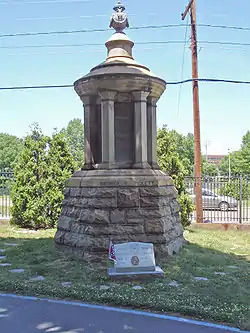
- Emma Gilham Page (1855–1933), wife of William Nelson Page
- Mann Page (1835–1904) Grand Master of Masons of Virginia 1894, American Civil War soldier, Co. F. 21st Virginia Infantry
- William Nelson Page (1854–1932), civil engineer, railway industrialist, co-founder of the Virginian Railway
- William Henry Palmer (1835–1926), Confederate officer
- Sallie Partington (1834–1907), actress
- John Pegram (1832–1865), U.S. Army officer, Confederate Army brigadier general
- William Ransom Johnson Pegram (1841–1865), U.S. Army officer, Confederate Army colonel
- George Pickett (1825–1875), U.S. Army officer, Confederate Army general, participated in Battle of Gettysburg
- LaSalle Corbell Pickett (1843–1931), author, wife of George Pickett
- William Swan Plumer (1802–1880), Presbyterian clergyman, educator and author
- Frederick Gresham Pollard (1918–2003), Lieutenant Governor of Virginia from 1966 to 1970
- John Garland Pollard (1871–1937), Governor of Virginia from 1930 to 1934
- Robert Nelson Pollard (1880–1954), Judge, U.S. District Court for the Eastern District of Virginia from 1936 to 1954
- William Wortham Pool (1842–1922), bookkeeper; tomb became associated with the Richmond Vampire
- John Pope, business executive (Allen & Ginter) (1856–96)
- John Powell (1882–1963), composer, ethnomusicologist and segregationist
- Lewis Franklin Powell Jr. (1907–1998), U.S. Supreme Court justice
- Bennet Puryear Jr. (1884–1982), Major General, USMC
R
- John Randolph (1773–1833), politician, leader in Congress from Virginia
- William Francis Rhea (1858–1931), Virginia lawyer, judge, and U.S. Congressman
- Dr. William Rickman (1731–1783), director of hospitals for the Continental Army of Virginia; devoted husband to the daughter of Signer of the Declaration of Independence Benjamin Harrison, Miss Elizabeth Harrison
- Conway Robinson (1805–1884), lawyer and legal scholar
S
- Dave Edward Satterfield Jr. (1894–1946), U.S. Congressman 1937–46
- Conrad Frederick Sauer (1866–1927), founder of the C. F. Sauer Company
- James Benjamin Sclater Jr. (1847–1882), co-founder of the Pi Kappa Alpha fraternity
- Mary Wingfield Scott (1898–1983), historic preservationist
- James Alexander Seddon (1815–1880), U.S. Congressman (1845–1851); Confederate Secretary of War
- Henry G. Shirley (1874–1941), Virginia civil servant[14]
- George Alvin Smith (1844–1908), merchant
- William Alexander Smith (1828–1888), U.S. Congressman from North Carolina (1873–75)
- William "Extra Billy" Smith (1797–1887), two-time governor of Virginia, Confederate general
- Harold Fleming Snead (1903–1987), Justice, Supreme Court of Virginia (1957–74)
- William E. Starke (1814–1862), Confederate general killed at the Battle of Antietam
- Walter Husted Stevens (1827–1867), U.S. Army lieutenant, C.S.A general
- Isaac M. St. John (1827–1880), Confederate General, American Civil War
- J. E. B. Stuart (1833–1864), American soldier, Confederate Army general
- Claude Augustus Swanson (1862–1939), Governor of Virginia (1906–10), U.S. Secretary of the Navy (1933–39)
T
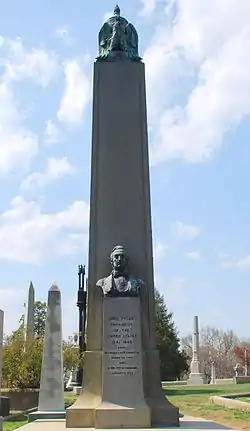
- John Banister Tabb (1845–1909), poet and priest
- William Elam Tanner (1836–1898), businessman
- William R. Terry (1827–1897), C.S.A general, American Civil War
- John Randolph Tucker (1879–1954), lawyer and civic leader
- Edna Henry Lee Turpin (1867–1952), author
- David Gardiner Tyler (1846–1927), Democratic politician, U.S. Congressman, and the fourth son of President John Tyler
- John Tyler (1790–1862), tenth President of the United States, a delegate to the Provisional Confederate Congress in 1861, and elected to the House of Representatives of the Confederate Congress
- Julia Gardiner Tyler (1820–1889), U.S. First Lady, wife of John Tyler
- Lyon Gardiner Tyler (1853–1935), historian, president of the College of William and Mary and the seventh son of President John Tyler
V
- Edward Valentine (1838–1930), sculptor
- Lila Meade Valentine (1865–1921), health care and education reformer, suffragist
W
- Edmund Waddill Jr. (1855–1931), U.S. Congressman (1889–1891); U.S. judge Fourth Circuit Court of Appeals (1921–31)
- Reuben Lindsay Walker (1827–1890), Confederate Army general
- Alexander Wilbourne Weddell (1876–1948), U.S. Ambassador to Argentina (1933–39) and Spain (1939–42)
- Beverly R. Wellford (1797–1870), Sixth President of the American Medical Association
- Louis O. Wendenburg (1861–1934), Member of the Senate of Virginia (1912–20)
- John Baker White (1794–1862), American military officer, lawyer, civil servant, and Clerk of Court for Hampshire County, Virginia (1815–61)
- Francis McNeece Whittle (1823–1902), Bishop of the Episcopal Diocese of Virginia (1876–1902)
- John A. Wilcox (1819–1864), U.S. Congressman (1851–1853); Confederate Congressman
- Channing Moore Williams (1829–1910), Missionary Bishop of the Episcopal Diocese of China and Japan
- Richard Leroy Williams (1923–2011), U.S. district court judge Eastern District of Virginia (1980–2011)
- George Douglas Wise (1831–1908), U.S. Congressman (1881–95)
- Henry A. Wise (1806–1876), Governor of Virginia, Confederate Army general
- John Sergeant Wise (1846–1913), U.S. Congressman (1883–85)
- Richard Alsop Wise (1843–1900), U.S. Congressman (1897–1901)
- Tom Wolfe (1930-2018), American author and journalist known for his association with New Journalism
- Serge Wolkonsky (1860–1937), Russian theatrical worker, son of Mikhail Sergeevich
Gallery
.jpg.webp) The cemetery caretaker's house (now apartments)
The cemetery caretaker's house (now apartments) The chapel at the entrance of Hollywood Cemetery
The chapel at the entrance of Hollywood Cemetery Fitzhugh Lee's grave
Fitzhugh Lee's grave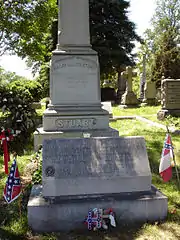 J.E.B. Stuart's grave
J.E.B. Stuart's grave Matthew Fontaine Maury's grave in Hollywood Cemetery
Matthew Fontaine Maury's grave in Hollywood Cemetery George Pickett's grave
George Pickett's grave The Sauer family Mausoleum in Hollywood Cemetery
The Sauer family Mausoleum in Hollywood Cemetery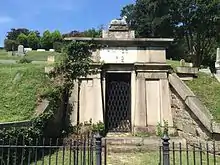 William Wortham Pool's grave in Hollywood Cemetery
William Wortham Pool's grave in Hollywood Cemetery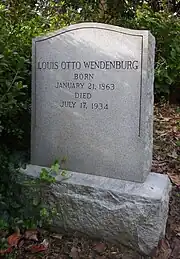 Louis Otto Wendenburg's grave marker
Louis Otto Wendenburg's grave marker Brig Gen William Edwin Starke's grave marker
Brig Gen William Edwin Starke's grave marker Maj Gen Samuel Jones grave marker
Maj Gen Samuel Jones grave marker Peachy Ridgway Grattan's marker in the family plot
Peachy Ridgway Grattan's marker in the family plot Dave Brockie Cenotaph at Hollywood Cemetery
Dave Brockie Cenotaph at Hollywood Cemetery
See also
References
- "National Register Information System". National Register of Historic Places. National Park Service. March 13, 2009.
- "Virginia Landmarks Register". Virginia Department of Historic Resources. Retrieved March 19, 2013.
- National Park Service. "Hollywood Cemetery and James Monroe Tomb". Retrieved August 5, 2014.
- https://www.hollywoodcemetery.org/william-h-haxall; Source of information: Library of Virginia Digital Collection; LVA Titled Files: Survey Report, Hollywood Cemetery: March 23, 1937; research by Malcolm T. Earley.
- "Re: Oliver Perry Baldwin, Publ". www.genealogy.com.
- Alfred L. Brophy, "The Road to the Gettysburg Address," Florida State University Law Review 43 (2016):831-905.
- Hollywood Cemetery (April 29, 2015), Confederate Memorial Pyramid (Hollywood Cemetery), archived from the original on December 22, 2021, retrieved October 15, 2018
- "Our History-Hollywood Cemetery". hollywoodgossipgalaxy.fun. Retrieved March 15, 2023.
- "165watchdog". www.civilwarfieldtrips.com.
- Kinney, Martha (1998). "If Vanquished I Am Still Victorious: Religious and Cultural Symbolism in Virginia's Confederate Memorial Day Celebrations, 1866–1930". The Virginia Magazine of History and Biography. 106: 237–266.
- Bryson, William Hamilton (1998). "George Wayne Anderson (d. 1922)". In Kneebone, John T.; et al. (eds.). Dictionary of Virginia Biography. p. 135.
- Freeman High School
- CWGC casualty record.
- "Henry G. Shirley Dies Unexpectedly". The Bristol Herald Courier. July 17, 1941. p. 1. Retrieved October 4, 2022 – via Newspapers.com.

Further reading
- Kollatz, Harry (2007). True Richmond stories: historic tales from Virginia's capital. Charleston, SC: History Press. ISBN 978-1-59629-268-0.
- Mitchell, Mary H (1985). Hollywood Cemetery: the history of a southern shrine. Richmond: Virginia State Library. ISBN 978-0-88490-109-9.
- Peters, John O (2010). Richmond's Hollywood Cemetery. Richmond, Va.: Valentine Richmond History Center. ISBN 978-0-615-39192-2.
External links
- Official website
- Hollywood Cemetery, Richmond, Virginia, a National Park Service Discover Our Shared Heritage Travel Itinerary
- Early 20th Century Views of Hollywood Cemetery, Rarely Seen Richmond Postcard Collection, VCU Libraries.
- James Monroe Tomb, Hollywood Cemetery, Richmond, Independent City, VA: 6 photos, 1 color transparency, 6 data pages, and 1 photo caption page at Historic American Buildings Survey
- List of Confederate Hospitals in Richmond, VA, during the Civil War
- Hollywood Cemetery at Find a Grave
- U.S. Geological Survey Geographic Names Information System: Hollywood Cemetery
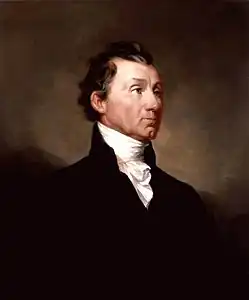

.png.webp)

